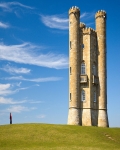Broadway Tower
Archaeology »
Archaeological Monuments » Broadway Tower
Broadway Tower - United kingdom
Broadway Tower is located in Worcestershire, England.
Broadway Tower monument was established on 1799.
Primary threats to Broadway Tower :
The second highest point of the Cotswold’s after Cleave Hill, Broadway Tower's base is 1,024 feet (312 meters) above sea level.
Historical facts of Broadway Tower :
Broadway Tower is a historic landmark located in the Cotswolds, England. This iconic tower stands on top of Beacon Hill, offering breathtaking views of the surrounding countryside. Here are some key historical facts about Broadway Tower:
- Construction and Purpose :
Broadway Tower was constructed in 1798 by the renowned architect James Wyatt. It was commissioned by Lady Coventry, wife of the 6th Earl of Coventry. The tower's primary purpose was to serve as a picturesque folly, a decorative structure built for aesthetic and entertainment purposes rather than any practical function.
- Architectural Design :
The tower's design is influenced by a combination of architectural styles, including Gothic, Norman, and Scottish baronial. It stands at a height of 65 feet (20 meters) and has a distinctive six-story structure. The tower's exterior is made of local limestone, and its battlements and turrets add to its medieval appearance.
- Historic Significance :
Broadway Tower holds historical significance as a lookout tower and a signaling station. It was originally intended to serve as a vantage point to observe the countryside and to communicate with other towers in the region. The tower's strategic location allowed for effective communication during times of potential invasion or unrest.
- Inspirational Connections :
The tower holds a special place in the history of the Arts and Crafts movement. It was a source of inspiration for renowned English designer William Morris and his associates. Morris referred to Broadway Tower as the "Saxon Tower" and considered it an architectural gem. The tower's romantic charm and picturesque setting greatly influenced Morris's artistic vision.
- Connection to Sir Thomas Phillips :
Broadway Tower is closely associated with Sir Thomas Phillips, a prominent figure in British history. Phillips was an art collector and book publisher who acquired the tower in the early 19th century. He transformed the tower into a private retreat and filled it with his extensive collection of books and artworks.
- Preservation and Restoration :
In the late 20th century, Broadway Tower underwent extensive restoration efforts to preserve its historic features. The tower was carefully renovated to ensure its structural integrity while maintaining its original architectural character. Today, it stands as a well-preserved testament to its past glory.
- Visitor Attraction :
Broadway Tower has become a popular visitor attraction and offers a range of amenities. Visitors can explore the tower's interior, which houses a museum showcasing the tower's history, exhibitions on local arts and crafts, and the works of William Morris. The top floor provides panoramic views of the picturesque Cotswold landscape, making it a favorite spot for photographers and nature enthusiasts.
- The Beacon :
An interesting feature of Broadway Tower is its association with beacon fires. In earlier centuries, beacon fires were lit on Beacon Hill to warn of impending threats or to celebrate significant events. Broadway Tower played a role in this system, and today, a replica of a beacon can be seen outside the tower.
- Broadway Tower stands as a captivating architectural gem, blending history, art, and natural beauty. Its rich heritage, panoramic views, and connection to influential figures make it a must-visit destination for history enthusiasts, art lovers, and anyone seeking to immerse themselves in the stunning Cotswold landscape.

